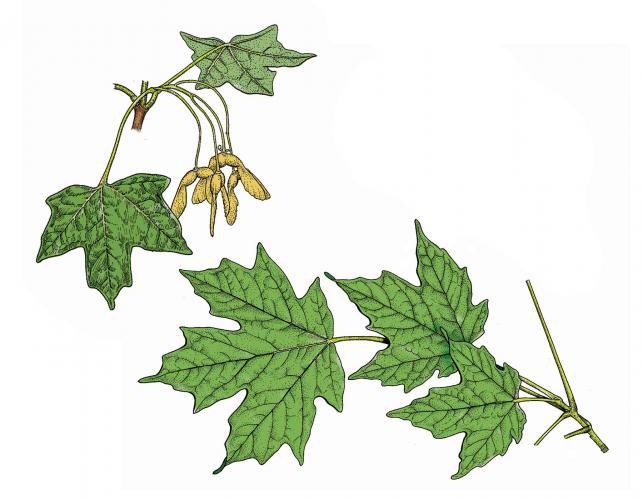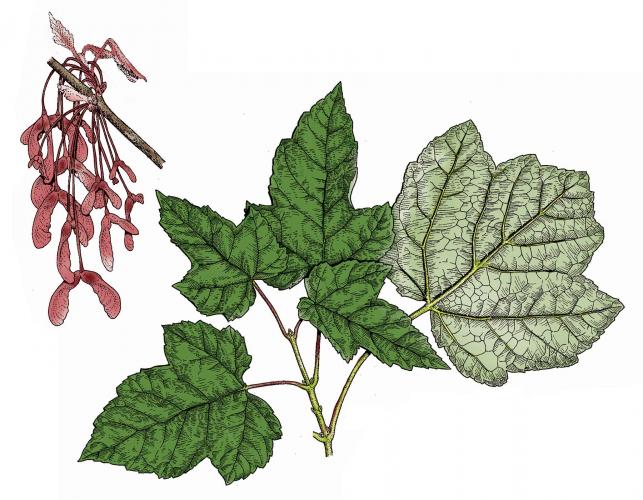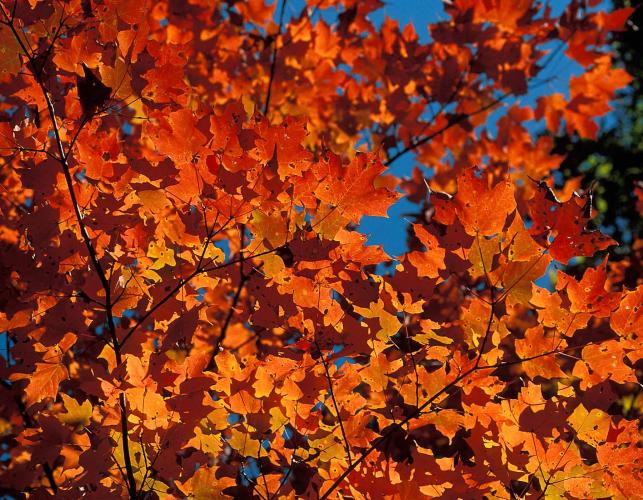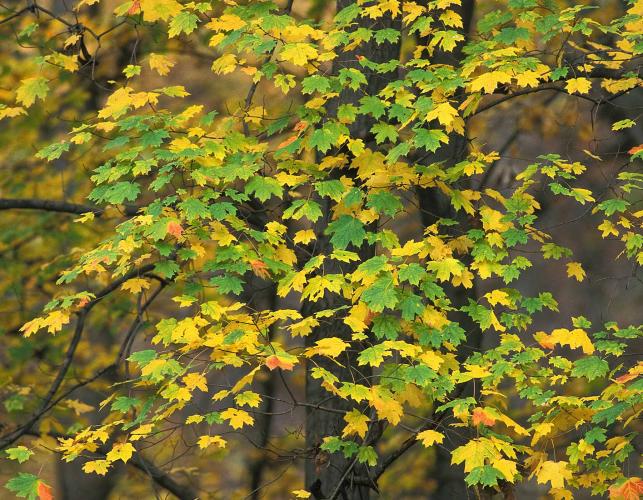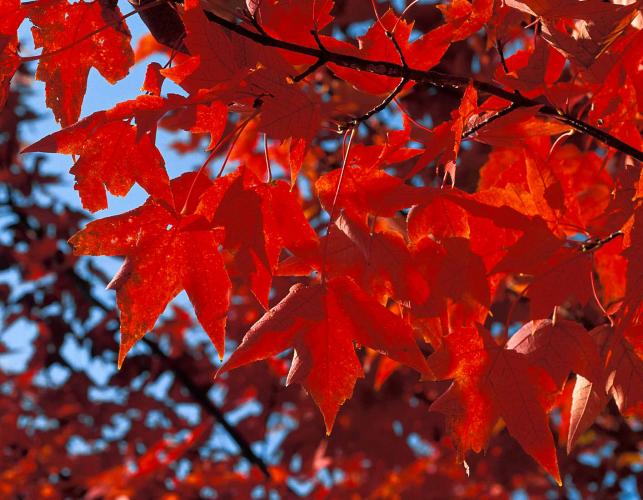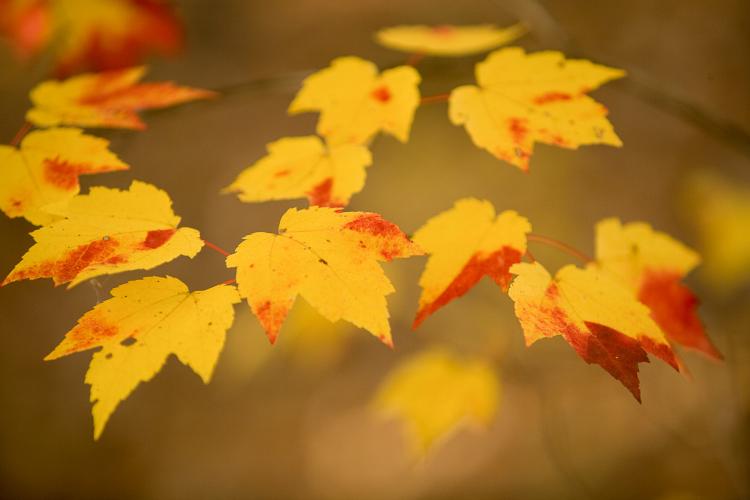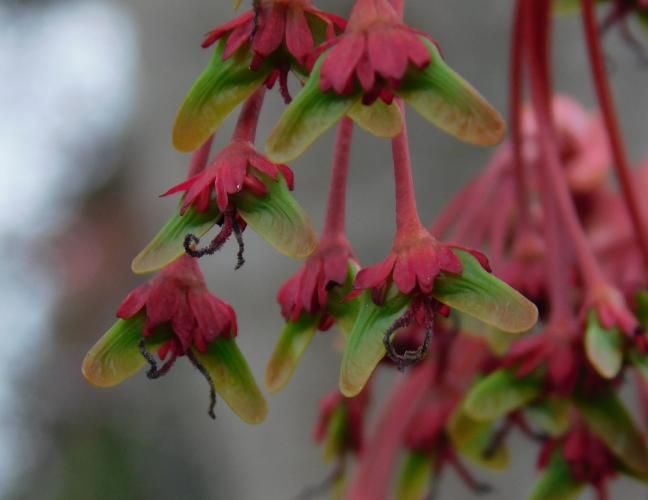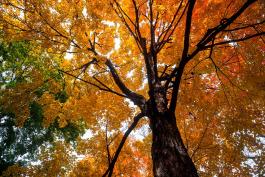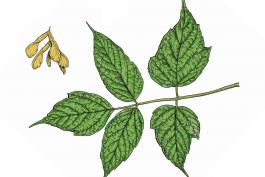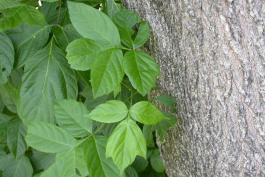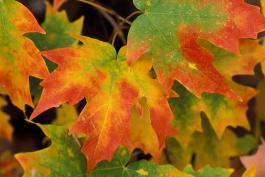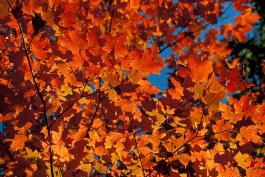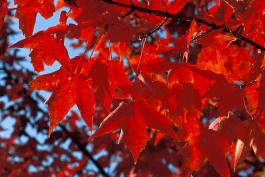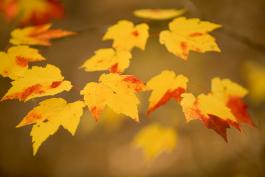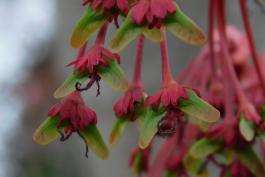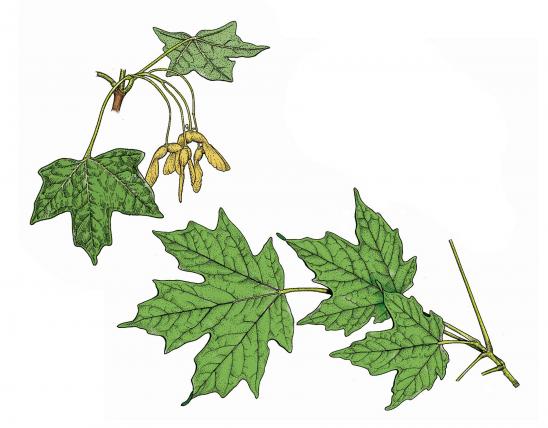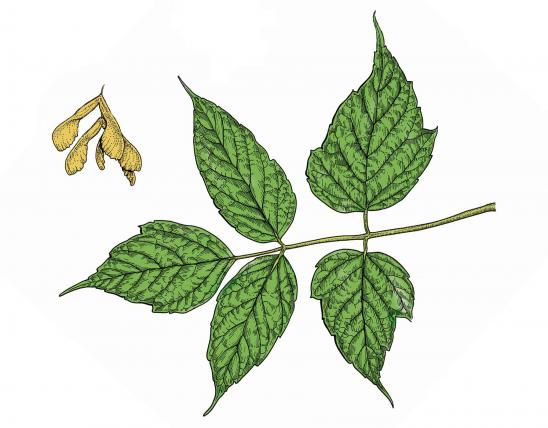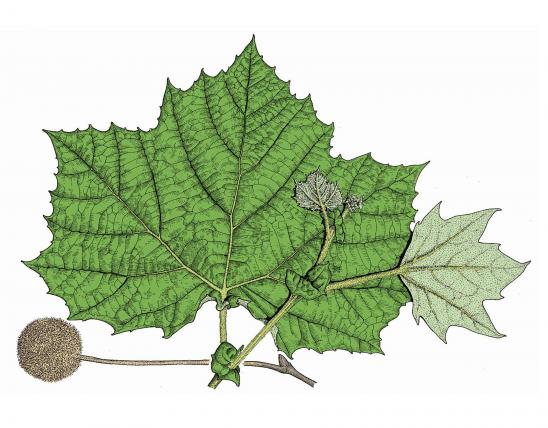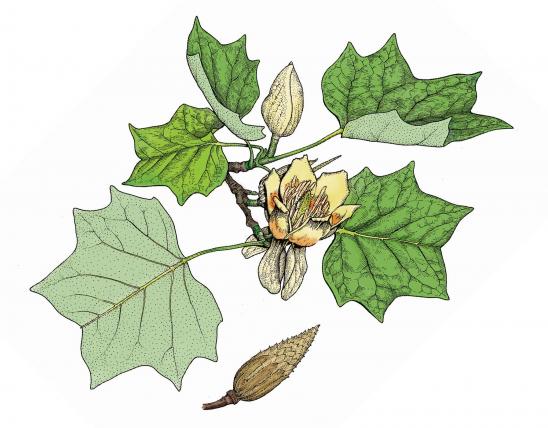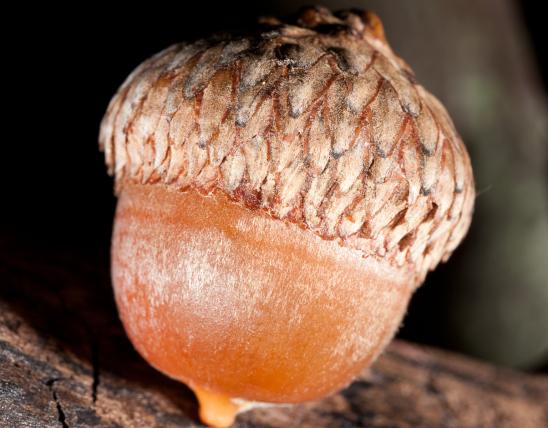
Missouri has five species of maples that are either native or naturalized, plus several that are known only in cultivation. Maples are important members of native ecosystems. They also provide stunning fall color, commercially important lumber, sap for syrup, and welcome shade on a hot summer day.
What distinguishes maples, as a group, from other woody plants? Depending on the species, maples may be shrubs or trees; Missouri’s native species are usually trees. Maples have distinctive leaves, flowers, and winged fruits (samaras).
The leaves of maples are opposite and have definite leaf stems (petioles). The leaf blades are usually simple and palmately lobed (often shaped something like a star or an outstretched hand), although one of our maple species (box elder) is pinnately compound, with 3 or 5 separate leaflets.
The flowers are not showy. They are radially symmetrical, usually with 4 or 5 sepals, which may be fused and are often colored; 4 or 5 free petals (or no petals); 3–8 strongly protruding stamens; and 1 pistil attached to 2 fused structures that will become the distinctive, paired maple “keys” (samaras).
Some maple species are monoecious (have separate male and female flowers on the same tree), while others are dioecious (have separate male-flowering trees and female-flowering trees). Some maple species may be either monoecious or dioecious.
The fruits of maples are the well-known maple keys (samaras) consisting of a basal seed with an elongated, flat, rather papery wing. The two seeds are initially fused but break apart when mature. The winged fruits often whirl down from the canopy like little helicopter wings.
Globally, there are about 115 species of maples. Missouri has 5 species that may be found growing on their own, out of cultivation (4 are native, and 1 is introduced):
- Sugar maple (also called hard maple and black maple) (A. saccharum) is a medium to large tree to about 100 feet tall. The leaves are usually 5-lobed (sometimes 3-lobed), the lobes pointed, toothless or irregularly toothed. The samaras spread at an angle of 90–120 degrees, dispersing after the leaves are mature. Missouri has 4 subspecies of sugar maple, and there are plenty more subspecies found in North America, too. Many subspecies have been considered separate species in the past. Sugar maple is a prized timber tree, for it grows rather slowly, resulting in hard wood that is valuable for lumber. In fall, the leaves turn yellow, orange, or red, often all on the same tree along with the unturned green leaves, making this one of the favorite trees for fall color. This is also the principal species for maple syrup.
- Red maple (A. rubrum) is a small to medium tree to 60 feet tall. The leaves have 3 (sometimes 5) lobes, with the middle lobe longer than the side lobes. The lobes are coarsely toothed. The lower surface is whitish. The flowers and fruits are red, the slender leaf stalk is red, and the leaves turn red in the fall. Paired samaras form a V or U (nearly parallel), with the wings only about ¾ inch long; they mature and drop in late spring. Grows in a variety of habitats, but especially in wetland, streamside, and other lowland areas. Because of its brilliant red fall color, a favorite tree in landscaping. Many cultivars exist.
- Silver maple, or soft maple (A. saccharinum) is a medium to large tree to 100 feet tall. The leaves have 5 deep, narrow, strongly pointy-tipped lobes; the middle lobe is the longest. The margins are toothed. The upper surface is green; the lower surface is silvery white (hence the name silver maple). Leaves turn yellow in fall. Samaras are large, spreading at an angle of 90–120 degrees, the wings slightly incurved; they disperse, spinning like little helicopters, before the leaves are mature. Common along streams and other low, damp areas. This tree grows quickly, resulting in soft, brittle wood. Popular as a landscaping shade tree due to its quick growth to a large size, but landowners pay for it later when older, brittle branches break during wind and ice storms. The thousands of seeds can become weedy in gardens, alleys, and even gutters on houses.
- Box elder or ash-leaved maple (A. negundo) is a medium-sized tree from 40 to 70 feet tall, well-known in yards as well as bottomlands, stream margins, and woodland edges. It’s the oddball maple, since it has feather-compound leaves instead of simple, lobed ones. Leaflets usually 3 or 5; with their coarse teeth, leaves that have 3 leaflets can look a lot like poison ivy. The dangling clusters of fruits, which are in winged pairs like other members of the maple family, reveal box elder’s identity as a true maple. Once a favorite dooryard shade tree, box elder has fallen out of favor because the branches break easily, the trees are prone to a variety of diseases and pests and are a host for annoying boxelder bugs, and the yellow fall color isn’t much to get excited about.
- Amur maple or Siberian maple (A. ginnala) is a large multistemmed shrub or small tree to 20 feet tall. Native to eastern Asia, it has been known to escape from cultivation in Missouri. It has spreading branches. Leaves are 1½ to 3 inches long with 3 lobes, each tapering to a sharply pointed tip; the center lobe is the longest; leaf margins are densely, irregularly toothed. Samaras are brown to red, narrowly spreading, sometimes appearing nearly parallel; they persist into the fall season.
Similar species: Several nonnative maples are cultivated in yards, parks, and other places. Norway, sycamore, and Japanese maple are examples:
- Norway maple (A. platanoides) looks a lot like a sugar maple but has milky sap, widely (horizontally) spreading samaras, and usually more points per leaf (there are 5 full lobes, plus 2 smaller lobes at the base); the leaves are darker green, too. The fall color is yellowish and not stunning. Usually planted as a shade tree.
- Sycamore maple (A. pseudoplatanus) has comparatively showy yellow flowers in small, branching, 5-inch-long clusters and are not produced until the tree is mostly leafed out. Leaves are leathery with prominent veins; they have 5 rather rounded lobes that are coarsely serrated. The pair of samaras usually form a 60-degree angle. The fall color is poor. Usually planted as a shade or street tree.
- Japanese maple (A. palmatum) has become very popular as an ornamental shrub or small tree usually to a maximum of 30 feet tall. The leaves have 5, 7, or 9 strongly tapered lobe tips; the samaras are rather small and widely spreading. There are numerous cultivars of this species, with some having extra-dissected, fringelike leaf lobes; orange, bronze, red, or purple foliage; a weeping habit; and so on. This species is popular among bonsai enthusiasts, too.
In addition to the many nonnative maples commonly cultivated, several other trees and shrubs have leaves that somewhat resemble the famous shapes of maples. If you’re new to tree identification, you might be confused by other trees with star-shaped leaves: sweet gum, sycamore, tulip tree, certain types of hawthorns, and some of the oaks in the red oak (or black oak) group.
Height varies by species and variety. Sugar maple and silver maple can reach 100 feet high.
Statewide. Different species have different regional distributional patterns and habitat preferences.
Habitat and Conservation
Although Missouri’s deciduous woodlands are typically dominated primarily by oaks and hickories, maples are important components of many woodland communities in Missouri.
Maples are common throughout much of eastern North America. Sugar maples, for example, are a major member of northern hardwood forests in New England and northern Michigan, Wisconsin, and Minnesota.
Status
Our native North American maples are highly valued for many reasons. They are important members of native ecosystems.
Human Connections
Maples are favorite ornamental and landscaping trees. Many species grow quickly and provide good shade, and many species provide excellent fall color. A number of cultivars exist, with unusual leaf color or other traits. If you are thinking about planting maples on your property, weigh the growth rate against resiliency and strength of wood; many of the fast-growing species are prone to breakage in wind or ice storms. Also make sure your maples are native to our latitude; ones native to the far north or south often cannot adapt to the timing of Missouri’s seasons.
The brilliant autumn color of maples contributes tremendously to fall color displays, and this has a big impact on tourism, contributing to the local economy. While New England is well-known for its autumnal maple displays, Missouri has fall beauty, too. In addition to maples, other brilliant species include sassafras, sweet gum, dogwoods, sumacs, and oaks.
Maples, especially the so-called hard maples (notably sugar maple), are highly valued for lumber, which is turned into a wide variety of wooden products ranging from baseball bats, bowling pins, and pool cues to fine furniture, flooring, butcher’s blocks, and more. Musical instruments, including guitars and other stringed instruments, woodwinds, and drums, are often made of maple. Maples whose wood develops unusual mottled or swirly growth patterns (often called flame maple, birdseye maple, and so on) are especially valuable to woodcarvers and furniture makers.
In the United States and Canada, the production of maple syrup and maple sugar is an export industry generating hundreds of millions of U.S. dollars annually. Native Americans showed European settlers how to simmer maple sap to concentrate the delicious sugar.
The maple leaf is a central symbol of Canada, appearing on its flag, coat of arms, military insignias, and more. As a national symbol, the maple tree signifies strength and endurance. Initially, the sugar maple was considered the emblem, but with 10 native maple species growing across that large nation, all are embraced as emblematic of the country.
Several maple species are favorites of bonsai artists. As a general rule, small-leaved, rather shrubby trees make the best bonsai subjects, which is why Japanese and trident maples are popular species. As with other deciduous bonsai, they require seasonal weather changes and must generally live outdoors to thrive.
Ecosystem Connections
As part of Missouri’s native natural communities, maples are part of the living fabric of vegetation that defines our unique forests, woodlands, savannas, streamsides, glades, and more. In yards, parks, roadsides, industrial parks, city streets, schoolyards, and college campuses, maples stand where we plant them, bringing a piece of nature into our human-altered habitats.
A wide variety of insects feed on maples. Scale insects, leafhoppers, plant bugs, mealybugs, and aphids suck the sap. Boring insects (usually the caterpillars or grubs of certain moth, beetle, or sawfly species) chew tunnels in the bark, wood, or leaf stems. One common borer is the larva of the maple callus borer moth, which bores into the inner bark and sapwood of maples.
Several types of caterpillars (the larvae of moths and butterflies) chew the leaves. One of these is the green-striped mapleworm, which is the larva of the rosy maple moth, a stunning pink and yellow silk moth that may appear at lights in midsummer. The fall cankerworm is another moth caterpillar that is often found on maples; it is in the geometrid family.
More moths whose caterpillars eat maples include the imperial moth, wavy-lined heterocampa, and interrupted dagger moth, plus the following, which are all in the geometrid family: common lytrosus (or great bark geometer), saw-wing moth, maple spanworm, and curve-toothed geometer.
In spring when the sap flow is strong, sap often weeps out of any breaks in the bark. For sugar maple and other species with sweet sap, this is a bonanza for numerous insects including honey bees and many adult butterflies and flies. Yellow-bellied sapsuckers often drill small holes into the bark of maples and drink the sap that flows out; they also may eat the ants that are attracted to the sap flow, too. Squirrels lick the sweet sap as well.
The bark of maples harbors a variety of insects, spiders, mites, and other small animals that are sought by woodpeckers, chickadees, warblers, wrens, and more.
Ecologists point out that trees that are never eaten by insects are serving little role in the food chain. Learn to tolerate some chewed leaves. Remember that insects that feed on plants become important food for birds and other animals. Especially in spring, birds need thousands and thousands of insects to feed their nestlings.
Early-flowering maples can provide a critical early-spring food source for bees.
Songbirds, gamebirds, many kinds of rodents, raccoons, rabbits, and even bears eat the seeds, flowers, or both. Deer and elk eat the leaves and small twigs. Beaver eat the wood and use it to build their lodges.
Maples provide important nesting habitat and shelter for a wide variety of animals. Birds and squirrels build nests among the branches. Squirrels, opossums, raccoons, and cavity-nesting birds (such as owls, woodpeckers, wood ducks, and chickadees) build nests in hollow places of mature maples where the heartwood has rotted out. Bats may roost in these hollow places, too.
Many kinds of beetles and other insects feed on the decaying wood of fallen maples. Indeed, fallen trees of many kinds become mini habitats. The various mushrooms, insects, salamanders, and others feed, directly or indirectly, on the log’s nutrients, gradually turning it into soil.
Maples, like most other trees, are susceptible to a number of pests or diseases that may inflict slight to heavy damage. When maples are healthy and not stressed by other diseases, drought, or other factors, they usually can withstand occasional outbreaks of most pests or disease.
Certain nonnative tree pests are invasive and can cause severe damage to our trees and forests. Ones that especially attack maple trees include the Asian longhorned beetle, gypsy moth, and spotted lanternfly. Learn how to identify them, so you can report them and slow their spread through early detection. Contact the Missouri Department of Conservation if you see signs of them.
Box elder and silver maple are well-known hosts of the eastern boxelder bug. This insect is native to Missouri, and it is not invasive (even though a swarm of them can seem overwhelming).
Maples, like with many other trees, can be excellent platforms for lichens to grow on. Lichens do not hurt trees; they merely grow on the bark in places where they get enough light for photosynthesis to take place in their tissues.

